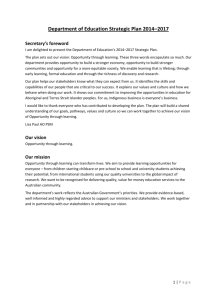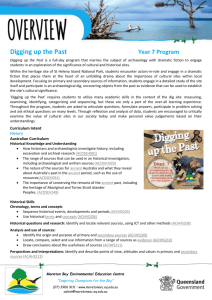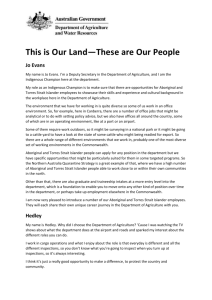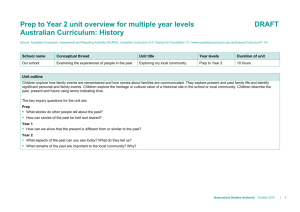Year 2 plan * Australian Curriculum: History template (P*2)
advertisement
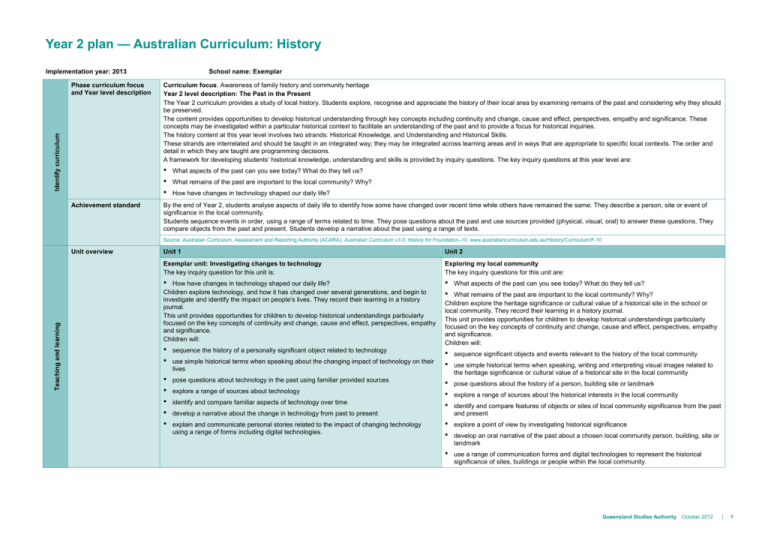
Year 2 plan — Australian Curriculum: History Implementation year: 2013 Identify curriculum Phase curriculum focus and Year level description School name: Exemplar Curriculum focus: Awareness of family history and community heritage Year 2 level description: The Past in the Present The Year 2 curriculum provides a study of local history. Students explore, recognise and appreciate the history of their local area by examining remains of the past and considering why they should be preserved. The content provides opportunities to develop historical understanding through key concepts including continuity and change, cause and effect, perspectives, empathy and significance. These concepts may be investigated within a particular historical context to facilitate an understanding of the past and to provide a focus for historical inquiries. The history content at this year level involves two strands: Historical Knowledge, and Understanding and Historical Skills. These strands are interrelated and should be taught in an integrated way; they may be integrated across learning areas and in ways that are appropriate to specific local contexts. The order and detail in which they are taught are programming decisions. A framework for developing students’ historical knowledge, understanding and skills is provided by inquiry questions. The key inquiry questions at this year level are: • • • Achievement standard What aspects of the past can you see today? What do they tell us? What remains of the past are important to the local community? Why? How have changes in technology shaped our daily life? By the end of Year 2, students analyse aspects of daily life to identify how some have changed over recent time while others have remained the same. They describe a person, site or event of significance in the local community. Students sequence events in order, using a range of terms related to time. They pose questions about the past and use sources provided (physical, visual, oral) to answer these questions. They compare objects from the past and present. Students develop a narrative about the past using a range of texts. Source: Australian Curriculum, Assessment and Reporting Authority (ACARA), Australian Curriculum v3.0: History for Foundation–10, www.australiancurriculum.edu.au/History/Curriculum/F-10 Teaching and learning Unit overview Unit 1 Unit 2 Exemplar unit: Investigating changes to technology The key inquiry question for this unit is: Exploring my local community The key inquiry questions for this unit are: • • • How have changes in technology shaped our daily life? Children explore technology, and how it has changed over several generations, and begin to investigate and identify the impact on people’s lives. They record their learning in a history journal. This unit provides opportunities for children to develop historical understandings particularly focused on the key concepts of continuity and change, cause and effect, perspectives, empathy and significance. Children will: • • • • • • • sequence the history of a personally significant object related to technology use simple historical terms when speaking about the changing impact of technology on their lives pose questions about technology in the past using familiar provided sources explore a range of sources about technology identify and compare familiar aspects of technology over time What remains of the past are important to the local community? Why? Children explore the heritage significance or cultural value of a historical site in the school or local community. They record their learning in a history journal. This unit provides opportunities for children to develop historical understandings particularly focused on the key concepts of continuity and change, cause and effect, perspectives, empathy and significance. Children will: • • • • • develop a narrative about the change in technology from past to present explain and communicate personal stories related to the impact of changing technology using a range of forms including digital technologies. What aspects of the past can you see today? What do they tell us? • • • sequence significant objects and events relevant to the history of the local community use simple historical terms when speaking, writing and interpreting visual images related to the heritage significance or cultural value of a historical site in the local community pose questions about the history of a person, building site or landmark explore a range of sources about the historical interests in the local community identify and compare features of objects or sites of local community significance from the past and present explore a point of view by investigating historical significance develop an oral narrative of the past about a chosen local community person, building, site or landmark use a range of communication forms and digital technologies to represent the historical significance of sites, buildings or people within the local community. Queensland Studies Authority October 2012 | 1 Teaching and learning Aboriginal and Torres Strait Islander perspectives History provides opportunities for children to strengthen their appreciation and understanding of Aboriginal peoples and Torres Strait Islander peoples and their living cultures. Specific content and skills within relevant sections of the curriculum can be drawn upon to encourage engagement with: • • • Aboriginal and Torres Strait Islander frameworks of knowing and ways of learning Indigenous contexts in which Aboriginal and Torres Strait Islander peoples live Aboriginal peoples’ and Torres Strait Islander peoples’ contributions to Australian society and cultures. The Australian Curriculum: History values Aboriginal and Torres Strait Islander histories and cultures. For Aboriginal and Torres Islander children, it provides an opportunity to see themselves within the curriculum and in an educational setting that respects and promotes their cultural identities. Children are taught that Australian Aboriginal societies are the longest surviving societies in the world and that Aboriginal and Torres Strait Islander peoples are two distinct groups. Children learn about Aboriginal and Torres Strait Islander occupation of the continent prior to colonisation by the British, and the ensuing contact and conflict between these societies. Children develop an awareness of the resilience of Aboriginal peoples and Torres Strait Islander peoples and the ways in which their expertise and experiences in contemporary science, education, the arts, sport and tourism; their inventions; and their knowledge of medicine have contributed to the development of a culturally diverse Australian society. General capabilities and cross-curriculum priorities Opportunities to engage with: Key to general capabilities and cross-curriculum priorities Literacy Numeracy Opportunities to engage with: ICT capability Critical and creative thinking Aboriginal and Torres Strait Islander histories and cultures Develop assessment Assessment For advice and guidelines on assessment, see: www.qsa.qld.edu.au | Year 2 plan Australian Curriculum: History Asia and Australia’s engagement with Asia Ethical behaviour Intercultural understanding Sustainability The following assessment will provide a targeted selection of evidence of a child’s learning across different assessment techniques and instruments. This evidence will be collected in a folio to make an overall on-balance judgment about a child’s achievement and progress at appropriate points, and to inform the reporting process. Unit 1 Unit 2 Assessment Assessment This unit provides children with ongoing opportunities to record historical learning in a Museum journal (history journal).* Children use the history journal to record and demonstrate the change in technology over time. The history journal may include: This unit provides children with ongoing opportunities to record historical learning in a My school, my community journal (history journal).* Children use the history journal to explore the historical and/or cultural significance of a school or local community site, building or person. The history journal may include: • • • • labelled diagrams/pictures written explanations annotated visual records summaries and analyses of newspaper or magazine articles from a historical perspective. Guided research: Presentation (Multimodal)** The purpose of this assessment is to make judgments about children’s abilities to research, collect, analyse and draw conclusions about historical sources. Children and teachers collaborate to examine how technology has changed over several generations by comparing past and present objects. Children choose a significant object to further develop their understanding of generational change in technology. They use a multimodal presentation to demonstrate their understanding of their chosen object and their use of historical skills. Skills may include: • • • • • • • 2 Personal and social capability sequencing familiar objects and events distinguishing between the past, present and future posing questions about the past using sources provided identifying and comparing features of objects from the past and present developing a narrative about the past using a range of communication forms and digital technologies exploring a range of sources about the past. • • • • • written explanations journal entries records of evidence gathered on a field trip annotated visual records summaries and analysis of written articles from a historical perspective. Guided research: Presentation (Multimodal)** The purpose of this assessment is to make judgments about children’s abilities to research, collect, analyse and draw conclusions about historical sources. Children and teachers use secondary sources to collaborate, discuss and investigate the significance of a small range of school or local community historical and/or cultural sites. Children use a multimodal presentation to demonstrate their understanding of the significance of historical sites, buildings or people and their use of historical skills. Skills may include: • • • • • • • sequencing familiar objects and events distinguishing between the past, present and future posing questions about the past using sources provided identifying and comparing features of objects from the past and present developing a narrative about the past using a range of communication forms and digital technologies exploring a range of sources about the past. Develop assessment Make judgments and use feedback Moderation * The history journal uses the assessment technique “guided collection of work”. In a guided collection of work, teachers and children collaborate on a series of focused tasks relating to a single cohesive investigative context. These tasks are conducted in class and in children’s own time. ** In this assessment technique “guided research, teachers and children collaborate to gather and record information. * The history journal uses the assessment technique “guided collection of work”. In a guided collection of work, teachers and children collaborate on a series of focused tasks relating to a single cohesive investigative context. These tasks are conducted in class and in children’s own time. ** In the assessment technique “guided research”, teachers and children collaborate to gather and record information. Teachers develop tasks and plan units. Teachers choose samples of children’s responses to questions to examine their understanding of historical perspectives. Teachers develop tasks and plan units. Teachers calibrate standards before marking by choosing samples of children’s work across the reporting standards (AP, MC, WW, EX, BA) and moderating to ensure consistency of judgment. Teachers select representative folios and meet to ensure consistency of teacher judgment before reporting on overall achievement within a folio. Queensland Studies Authority October 2012 | 3 Year 2 History: review for balance and coverage of content descriptions, including emphasis on historical understandings Historical Knowledge and Understanding Historical Knowledge 1 2 The Past in the Present The history of a significant person, building, site or part of the natural environment in the local community and what it reveals about the past (ACHHK044) The importance today of an historical site of cultural or spiritual significance; for example, a community building, a landmark, a war memorial (ACHHK045) The impact of changing technology on people’s lives (at home and in the ways they worked, travelled, communicated, and played in the past) (ACHHK046) Historical Skills Historical Understandings1 The key concepts of historical understanding are: 1 2 Historical Skills Continuity and change Chronology, terms and concepts Continuities are aspects of the past that have remained the same over certain periods of time. Changes are events or developments from the past that represent modifications, alterations and transformations. Cause and effect The relationship between a factor or set of factors (cause/s) and consequence/s (effect/s). These form sequences of events and developments over time. Perspectives A point of view or position from which events are seen and understood, and influenced by age, gender, culture, social position and beliefs and values. Empathy Distinguish between the past, present and future (ACHHS048) Explore a range of sources about the past (ACHHS050) Identify and compare features of objects from the past and present (ACHHS051) Historical questions and research Analysis and use of sources Perspectives and interpretations An understanding of the past from the point of view of the participant/s, including an appreciation of the circumstances faced, and the motivations, values and attitudes behind actions. Significance 2 Sequence familiar objects and events (ACHHS047) Pose questions about the past using sources provided (ACHHS049) 1 Explore a point of view (ACHHS052) Explanation and communication The importance that is assigned to particular aspects of the past, such as events, developments, movements and historical sites, and includes an examination of the principles behind the selection of what should be investigated and remembered. Develop a narrative about the past (ACHHS053) Use a range of communication forms (oral, graphic, written, role play) and digital technologies (ACHHS054) Source: Australian Curriculum, Assessment and Reporting Authority (ACARA), Australian Curriculum v3.0: History for Foundation–10, www.australiancurriculum.edu.au/History/Curriculum/F-10 1 The historical understandings are derived from the content descriptions and achievement standards, and are supported by Historical Skills. The Year level description provides information about the development of historical understandings through key concepts. The definitions of historical understandings are based on the glossary terms published in Australian Curriculum v3.0: History for Foundation-10, www.australiancurriculum.edu.au/History/Curriculum/F-10. 4 | Year 2 plan Australian Curriculum: History


